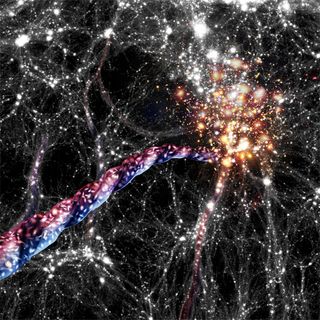Astronomers discover largest known spinning structures in the universe
They're hundreds of millions of light-years long.

Tendrils of galaxies up to hundreds of millions of light-years long may be the largest spinning objects in the universe, a new study finds.
Celestial bodies often spin, from planets to stars to galaxies. However, giant clusters of galaxies often spin very slowly, if at all, and so many researchers thought that is where spinning might end on cosmic scales, study co-author Noam Libeskind, a cosmologist at the Leibniz Institute for Astrophysics Potsdam in Germany, told Space.com.
But in the new research, Libeskind and his colleagues found that cosmic filaments, or gigantic tubes made of galaxies, apparently spin. "There are structures so vast that entire galaxies are just specks of dust," Libeskind said. "These huge filaments are much, much bigger than clusters."
Related: The best Hubble Space Telescope images of all time!
Previous research suggested that after the universe was born in the Big Bang about 13.8 billion years ago, much of the gas that makes up most of the known matter of the cosmos collapsed to form colossal sheets. These sheets then broke apart to form the filaments of a vast cosmic web.
Using data from the Sloan Digital Sky Survey, the scientists examined more than 17,000 filaments, analyzing the velocity at which the galaxies making up these giant tubes moved within each tendril. The researchers found that the way in which these galaxies moved suggested they were rotating around the central axis of each filament.
The fastest the researchers saw galaxies whirl around the hollow centers of these tendrils was about 223,700 mph (360,000 kph). The scientists noted they do not suggest that every single filament in the universe spins, but that spinning filaments do seem to exist.
Get the Space.com Newsletter
Breaking space news, the latest updates on rocket launches, skywatching events and more!
The big question is, "Why do they spin?" Libeskind said. The Big Bang would not have endowed the universe with any primordial spin. As such, whatever caused these filaments to spin must have originated later in history as the structures formed, he said.
One possible explanation for this rotation is that as the powerful gravitational fields of these filaments pulled gas, dust and other material within them to collapse together, the resulting shearing forces might have spun up this material. Still, right now, "we're not really sure what can cause a torque on this scale," Libeskind said.
The scientists now seek to understand the origin of filament spin through computer simulations of how matter behaves on the largest cosmological sales. The researchers detailed their findings online June 14 in the journal Nature Astronomy.
Follow us on Twitter @Spacedotcom and on Facebook.
Join our Space Forums to keep talking space on the latest missions, night sky and more! And if you have a news tip, correction or comment, let us know at: community@space.com.

Charles Q. Choi is a contributing writer for Space.com and Live Science. He covers all things human origins and astronomy as well as physics, animals and general science topics. Charles has a Master of Arts degree from the University of Missouri-Columbia, School of Journalism and a Bachelor of Arts degree from the University of South Florida. Charles has visited every continent on Earth, drinking rancid yak butter tea in Lhasa, snorkeling with sea lions in the Galapagos and even climbing an iceberg in Antarctica. Visit him at http://www.sciwriter.us